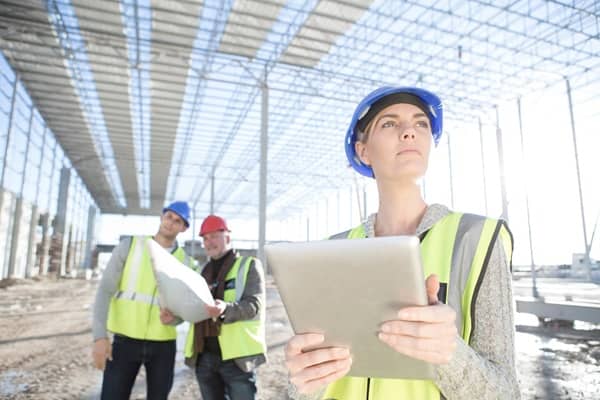Construction, as an activity, may date back further than modern humans themselves. Evidence suggests that early human-like ancestors built shelters as far back as 1.8 million years ago. Fast forward to 6,000 years ago in Mesopotamia, where using bricks laid the foundation for modern construction methods that brought about large buildings and road networks.
The Industrial Revolution marked a turning point in construction, introducing new materials, techniques, and career opportunities. Innovations like the Bessemer Process revolutionized steel production, enabling the construction of towering buildings and reshaping urban landscapes.
However, despite rapid advancements in materials and machinery, construction sites often lagged in adopting new technologies, with many resembling those of the 1980s, even in recent decades.
Today, the industry is catching up. As of 2023, the global construction market size stood at approximately USD 13.57 trillion and is projected to grow at a compound annual growth rate (CAGR) of 6.5%, reaching USD 23.92 trillion by 2032. Much of this growth is driven by technological innovation.
In an era of rising domestic and international demand, construction firms must embrace cutting-edge technologies to stay competitive. But how exactly is technology reshaping the industry? From streamlining operations to enhancing safety and efficiency, technology now touches nearly every aspect of construction.
Read on to discover the transformative impact of technology on the construction industry.
Types of technology used in construction
Scan to BIM
One of the most impactful advancements in construction is scan-to-BIM. This process involves using 3D laser scanning to capture precise data of a physical structure or site and transform it into a highly accurate Building Information Model (BIM). The benefits are profound: reducing project delays, minimizing costly errors, and improving stakeholder collaboration.
Survey2Plan provides cutting-edge Scan to BIM services tailored to diverse project requirements. By leveraging this technology, engineers and architects gain a clear, data-rich foundation for planning, designing, and maintaining structures, whether renovations or large-scale infrastructure projects.
Geographic Information Systems (GIS)
Geographic Information Systems (GIS) are transforming the construction industry by enhancing decision-making, planning, and resource management. GIS allows construction teams to analyze spatial data, evaluate site suitability, and plan projects precisely. By integrating diverse data sources, GIS supports efficient resource allocation, such as real-time materials, equipment, and labor tracking. It also facilitates the design and analysis of infrastructure, providing valuable insights for road alignments, utility placements, and environmental impact assessments.
GIS improves project visualization through interactive maps and 3D models, enabling managers to monitor progress and address issues promptly. Additionally, it aids in risk assessment by identifying environmental hazards and developing mitigation strategies, enhancing site safety, and reducing delays. Integrating GIS with Building Information Modeling (BIM) further improves stakeholder collaboration, ensuring well-informed decision-making throughout the project lifecycle.
For construction firms, embracing GIS increases efficiency, reduces costs, and improves project outcomes, making it an indispensable tool in the modern construction landscape. Comprehensive GIS services, like those provided by GIS Navigator, help streamline operations and ensure sustainable project execution.
Drones
It is essential to survey the land on which a project will be built before designing and constructing it. Surveys are sometimes necessary to obtain a building permit since they offer crucial information that needs to be considered while designing the foundation to ensure structural soundness.
Surveying land with drones is more cost-effective and efficient than having people physically cover a huge region. They can provide information on land and site analysis by flying over an area and taking pictures in a fraction of the time. As the project develops, drones can potentially be used for surveillance and equipment tracking.
GPS tracking
GPS tracking is crucial if your business oversees a fleet of equipment. You can use satellites to communicate with your home base and equip your cars with GPS equipment. This will allow your business to view the real-time location of your vehicles. More integration with other systems will soon be a part of GPS tracking. Data on field and equipment conditions will be instantly available through telematics systems and fleet tracking programs. To enhance operations, they will input such data onto a consolidated dashboard.
Benefits of technology in construction
Increased job site efficiency
The technology significantly increases job site efficiency by optimizing labor utilization and completing routine activities. It also simplifies scheduling, detects problems earlier, and speeds up land surveying. This results in more efficient operations and significantly lowers the likelihood of delays, eventually accelerating project deadlines.
Increased quality
Another area that has improved is the quality of construction. Robots and 3D printing provide increased accuracy and consistency in construction operations, while laser-based instruments guarantee precise measurements. Together, these technologies improve overall building standards, decrease errors, and increase the longevity of structures.
Cost savings
Over time, integrating technology into your processes can result in significant cost savings, even though the initial investment to improve your systems may appear expensive. Time and money can be saved by using virtual testing rather than creating and rebuilding accurate models. Improved material monitoring systems also lessen the chance of materials being lost or squandered and assist in avoiding overordering, which results in more economical use of resources.
Worker safety
Technology has elevated the importance of worker safety. Wearable technology can identify early indicators of health problems and track employees’ health. Sensors make early detection of risks, such as building instability, possible. More attention has also been paid to safety procedures and training since technology can test methods for efficacy.
Conclusion
Almost every facet of the construction industry is being revolutionised by technology. If you haven’t already, it’s time to embrace some emerging technologies propelling the construction industry forward. You should use the newest technology as the building sector grows throughout the coming years. They will assist you in staying up while your business gains from the expansion of the industry.
Consult the professionals if you’re unsure which technology to use. Even a minor adjustment might significantly impact your bottom line.






Leave a Comment